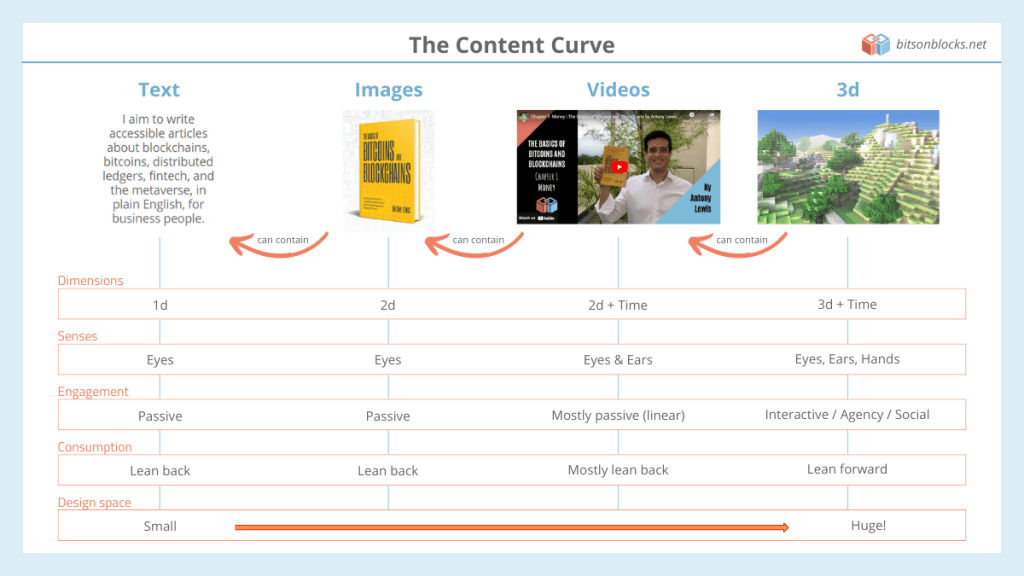A mental model I am developing is how to think about 3d content is as a fourth format for content, extending a complexity curve from text to images to video (including audio) – and now 3d. A simple way to think about virtual worlds and experiences is format and access. 3d content is the format; hardware is the way we access it.
3d content sits in a special place on the content curve; it is categorically different to previous forms of digital content, and opens up an entirely new design space that will affect all industries. Let’s explore the content curve.
The content curve
We can think of four main forms of content: text, images, videos, and 3d.
Now, of course, the illustration above is just an image embedded in a blog post because (1) I’m lazy and (2) I want to be consistent. I could have made the text actual text, the video a Youtube embed, and the 3d content some sort of embedded 3d object that you can rotate – you’ve probably seen this on e-commerce websites). But you get the idea.
How is this useful? How does the content curve help our thinking?
As we move across the curve, the content becomes more complex in a number of ways (more on this in a bit), but also the design space, ie what we can do with the content, expands.
🖼️ We can do more with images than with text (images can contain text, and then there’s the graphical element).
📹 We can do more with videos than with images or text (videos can contain images and text, and then there’s the moving element).
🕹️ And we can do so much more with 3d content than we can with videos, images, or text (3d content can contain videos, images, and text, and then there’s the 3d bit).
Note: Just because we can do more with each form of content, it doesn’t mean the successor makes the predecessor redundant. Each content format has its place for sure, and excels at its job.
Complexity and Characteristics
As we move across the curve, the content becomes more complex in a number of ways:
- There are more dimensions. Text more or less goes in a straight line – it has width, it’s 1-d. Images take up width and height.- it’s 2-d. Videos add a new dimension – they take time to consume – determined by the content producer. 3d content is, well, 3-d and introduces a relational component (think VR or AR, where the content adapts as you move through space).
- The number of senses we use increases. With text and images we use our eyes only. With videos, we use eyes and ears. With 3d we use eyes, ears, and we input (hands?) in order to make the 3d scene change.
- The way we engage with content changes. With text and images, we are given the content; we can’t do anything with it. With videos we can play, pause and rewind. With 3d content, it is interactive, we have agency, and the content can be responsive. We can experience the same environment as other people simultaneously, and interact with the content such that it affects their experience; and you can engage socially with other users too. (Note: Just because we can engage more across the curve, it doesn’t mean the content is necessarily more engaging (compelling)… a good novel beats a lousy 3d game any day.)
And so the way we consume 3d differs. With text, images, and videos, we lean back to consume. The content is fed to us. With 3d, we lean forward to engage. We interact. (Yes, you can watch a video or stream of someone playing Minecraft, but that’s effectively a video format, rather than a 3d format.)
So now our content curve looks like this:

What does this mean?
While 3d can be described as “just another form of content”, it’s so much more than that. Its unique characteristics, as described above, allows for content that is that much more compelling and engaging than with just text, images, and video. Attention flows to compelling experiences. And money flows to where attention goes.
Together with the right access devices (AR/VR headsets, wearables, non-wearables such as smart mirrors, but yes, even our humble desktop, laptop, and mobile screens), 3d content opens up a completely new design space for digital content consumption and interaction.
3d content, whether accessed using headsets or screens, will change consumer patterns, retail behaviour, business processes, and entire industries. It opens up a new, vast, (virtual) world of possibilities. And, if you’ve got this far, you’ll notice I wrote this all without saying AI or Metaverse! (d’oh)